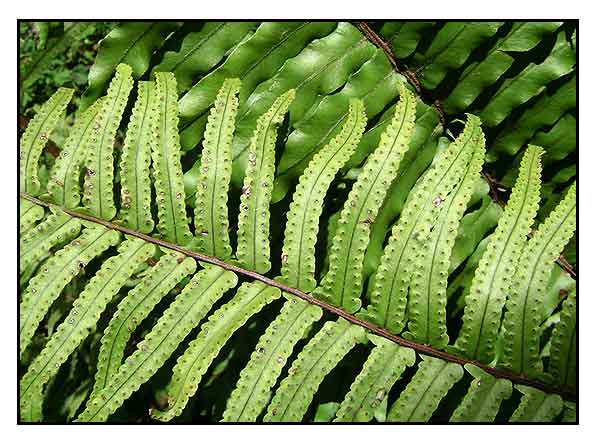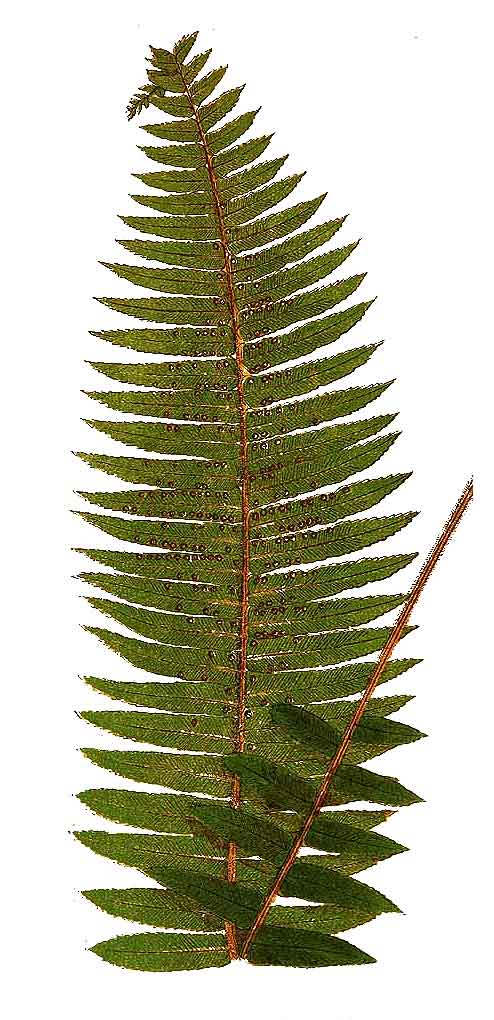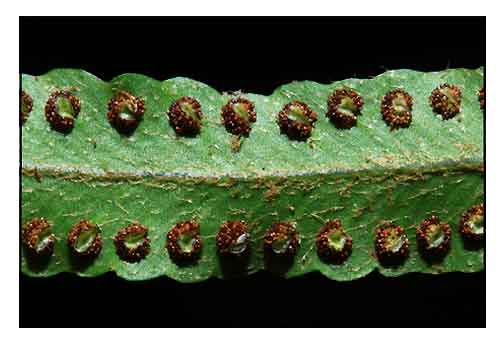
Family • Nephrolepidaceae
Bayangbang
Alolokdo
Nephrolepis hirsutula (G. Forst.) C. Presl
ROUGH SWORD FERN
| Scientific names | Common names |
| Aspidium exaltatum var. hirsutulum F.M.Bailey | Alolokdo (Bis.) |
| Aspidium hirsutulum (G.Forst.) Sw. | Bayangbang (Tag) |
| Aspidium pilosum Langsd. & Fisch. | Lagunton (Ilk.) |
| Aspidium tomentosum Willd. | Sipeng (Philippines) |
| Lepidoneuron hirsutulum (G.Forst.) Fee | Taro-taro (Philippines) |
| Nephrodium hirsutulum (G. Forst.) C. Presl | Asian sword fern (Engl.) |
| Nephrodium hirsutum Bory | Rough sword fern (Engl.) |
| Nephrodium multifidum Rich. | Scaly sword fern (Engl.) |
| Nephrolepis cisneiriana f. duffi (T.Moore) Proctor | Scurfy sword fern (Engl.) |
| Nephrolepis duffii T.Moore | |
| Nephrolepis exaltata var. hirsutula (G. Forst.) Baker | |
| Nephrolepis hirsutula (G. Forst.) C. Presl | |
| Nephrolepis multifida (Rich.) Mett. | |
| Nephrolepis pilosa (Langsd. & Fisch.) C.Presl | |
| Nephrolepis rufescens f. tripinnatifida Baker | |
| Nephrolepis wallichiana C.Presl. | |
| Polypodium ferrugineum Roxb. | |
| Polypodium hirsutulum G. Forst. | |
| Polystichum hirsutulum (G. Forst.) Bernh. | |
| In another example of nomenclatural confusion in Philippine herbal plants, N. cordifolia's common name bayabang 'is phonetically confused with bayangbang (N. hirsutula). Alolokdo is shared by both N. hirsutula and N. biserrata. | |
| This compilation lists the 3 species as: (1) Nephrolepis cordifolia (Bayabang, Common sword fern), (2) N. hirsutula (Bayanbang, Rough sword fern), and (3) Nephrolepis biserrata (Alolokdo, Broad sword fern). |
|
| Nephrolepis hirsutula (G. Forst.) C. Presl. is an accepted species. KEW: Plants of the World Online | |
| Other vernacular names |
| AMERICAN SAMOA: Vao tuaniu. |
| COOK ISLANDS: Maire, Tuartou, Tu-rautou, Turei'aua, Turoutou. |
| CUBA: Helecho, Periquita, Puntero. |
| NEW ZEALAND: Lau maile kimoa, Maile kimoa. |
| INDONESIAN Pakis kinca, Paku jeler, Paku sepat, Paku jangkang. |
Botany Rhizome erect, very short, bearing a tuft of leaves and many long slender runners, bearing appressed, imbricating, hairy scales 3-4 mm long. Petiole 25 cm or longer, scaly; lamina erect or arching, in outline 60-100 cm × 16 cm, pinnae very close and overlapping with their widened bases, covered with small hair-like scales when young, lowest pinnae more widely spaced and 1.5 cm long; sterile pinnae up to about 8 cm × 1.5 cm with a triangular auricle at base, margins irregularly crenate, slightly falcate at apex, veins hardly visible in living plant, ending in small hydathodes near the margin often with white scales; fertile pinnae narrower, up to about 1 cm wide. Sori close to or touching the margin; indusia round-reniform, about 1 mm in diameter. (7)
Constituents Properties Availability |
Updated April 2023
August 2020
![]()
 |
| PHOTOS / ILLUSTRATIONS |
| IMAGE SOURCE: Photograph: Nephrolepis hirsutula / Tau'olunga / click on image to go to source page / CC by SA 3.0 / Wikimedia |
| OTHER IMAGE SOURCE: Illustration / Nephrolepis hirsutula / click on image to go to source page / Lowe, E J; Ferns (A History of Ferns) British and exotic (1856-1860) / PlantIllustrations.org |
| OTHER IMAGE SOURCE: Photograph: Nephrolepis hirsutula / © Cheng-Wei chen / Non-commercial use / click on image to go to source page / Flora of Solomon Islands |
Additional
Sources and Suggested Readings |
• |
DOI: It is not uncommon for links on studies/sources to change. Copying and pasting the information on the search window or using the DOI (if available) will often redirect to the new link page. (Citing and Using a (DOI) Digital Object Identifier) |
| List of Understudied Philippine Medicinal Plants |
• |
 |




